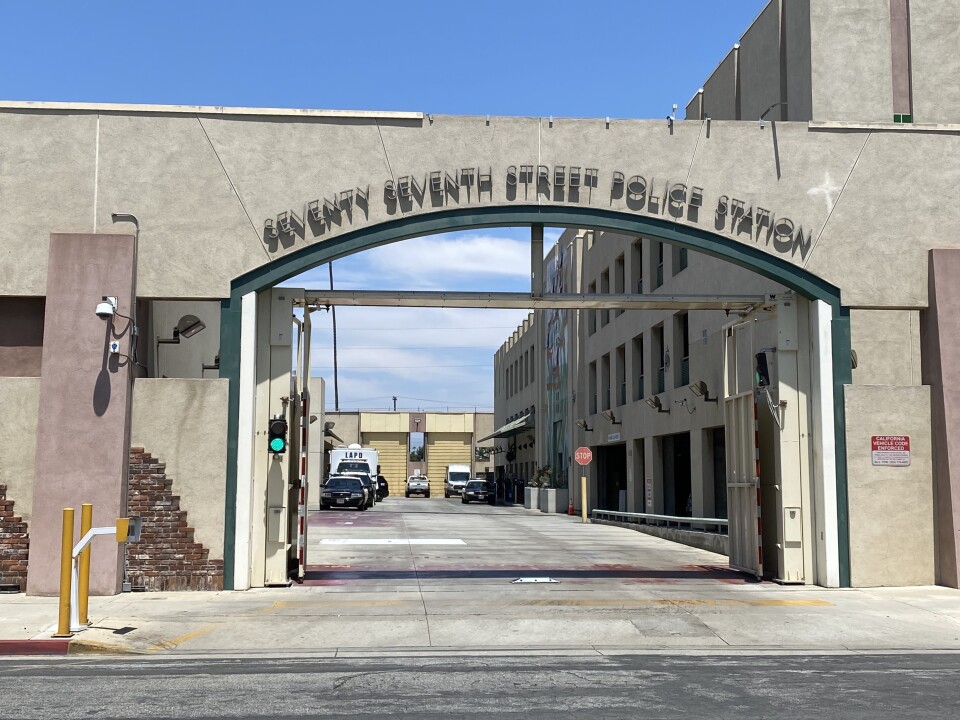Truth matters. Community matters. Your support makes both possible. LAist is one of the few places where news remains independent and free from political and corporate influence. Stand up for truth and for LAist. Make your year-end tax-deductible gift now.
Why This Pilot Program To Divert People From Jail Into Treatment Is Based At A Big LAPD Station

L.A. County’s effort to divert people with mental health and substance abuse issues away from the criminal justice system has led to a new pilot project that’s run out of the LAPD’s huge 77th Street station in South L.A.
The initiative partners the police with a nonprofit that works to get people into treatment. The program focuses on people who have a mental illness, substance use disorder, or are unhoused, who have been arrested for certain low-level, non-violent offenses — like trespassing, shoplifting or drug possession.
“We’re taking people who are being put into the system and bringing them back into society,” said Analisa Martinez of Special Services for Groups’ Project 180, the organization working with the LAPD on the pilot. “A lot of these people have nothing right now; they don’t have a place to live, they don’t have jobs.”
It’s significant that only people arrested for certain low-level crimes can qualify for the program, said LAPD Captain Christopher Zine, who helped develop the pilot.
“We’re balancing victims' rights as well, so especially when it came to the eligible charges, we needed to make sure that it wasn’t gonna be for the serious and violent felons,” he said.
How It Works
If LAPD detains someone for one of the approved low-level offenses and they don’t have a serious criminal record, Martinez or someone else from her team — who are in the station’s basement 24/7 — steps in.
“We will interview the person, let them know what our program is, what services we can offer,” she said, adding that a key component of the pilot is that the individual “has to agree to work with us.”
Working with Martinez could mean going to a psychiatric emergency room or an in-patient drug treatment program. If the person does agree to the help, the criminal charges against them are put on hold. If the person sticks with the program, the charges are eventually dropped.

“It’s rewarding to be a part of something that’s so new, and to see where it can go,” Martinez said. “I think it can benefit our community a lot.”
Challenges To Success
There are obstacles to success. Emily Bell, who helps guide the pilot for Martinez’s nonprofit, said for one thing, the setting for interviews is far from ideal.
“They’re in the cell. It’s like a big plexiglass and you have to kind of yell a little bit,” she said. “It’s not the perfect environment for engagement, obviously.”
A more fundamental challenge is that the arrestees have to affirm they live with a mental illness or struggle with drug addiction.
You can have a person who has 14 drug cases and they’ll still say ‘Oh no, I don’t have a drug problem.'
But getting people to talk about their struggles with mental illness or substance use isn't easy, said retired Judge Songhai Armstead, executive director of LA County’s Alternatives to Incarceration Initiative, which is overseeing the pilot.
“I can tell you as a sitting judge, you can have a person who has 14 drug cases and they’ll still say ‘Oh no, I don’t have a drug problem,’” she said.
Armstead told us she wants to work on getting staff to alter their interview techniques.
“I know in court, when I would divert people, [and] I know that they need treatment, I would never say, ‘Do you need treatment?,’” she said. “I would say, ‘Hey, can you do me this favor? If you can go and see this person once a month and they can tell me how you’re doing, it would really help us work on your case.”
Another problem is follow-through. At the Aug. 3 Police Commission Meeting, Deputy Chief Kris Pitcher said 21 people were diverted in the pilot’s first six weeks. But about half didn’t stick with the program and could end up facing criminal charges after all.
The Stakes Are High
If the county ultimately determines the 77th Street pilot to be a success, the plan is to expand it to 10 other police and sheriff’s stations, from Pomona to Long Beach.

The stakes are high for diversion efforts like this one. During the pandemic, even as the Sheriff’s Department released some people from jail, the mental health population behind bars rose to more than 6,000.
What’s more, a 2020 Rand study estimated that about 60% of L.A. County’s jail population could likely be diverted to treatment.
The 77th Street pilot is a welcome initiative, said Stephanie Brooks Holliday, who co-authored the Rand study. She likes that the program places a service provider on-site 24/7. But she does have some concerns.
“Increasing diversion is really important, but if you don’t have the community-based capacity to then meet the needs of those folks, then your program can only be so effective,” Holliday said.
It’s a concern Armstead says the county understands and is trying to address. “There’s a lot more money coming down for housing and services,” she said, pointing to the $187 million plan the L.A. County Board of Supervisors approved last week.
Armstead said her office is also launching an “incubation academy,” where smaller providers can learn how to scale up, get funding and contract with the county.








